| Please access the following URL if you want to secure using SSL. All pages in the site will be secure pages. |
https://secure02.blue.shared-server.net/www.fish-food.co.jp/message english 7.2021.html |
Welcome to FISH FOOD TIMES
Jul. 2021 issue No.211

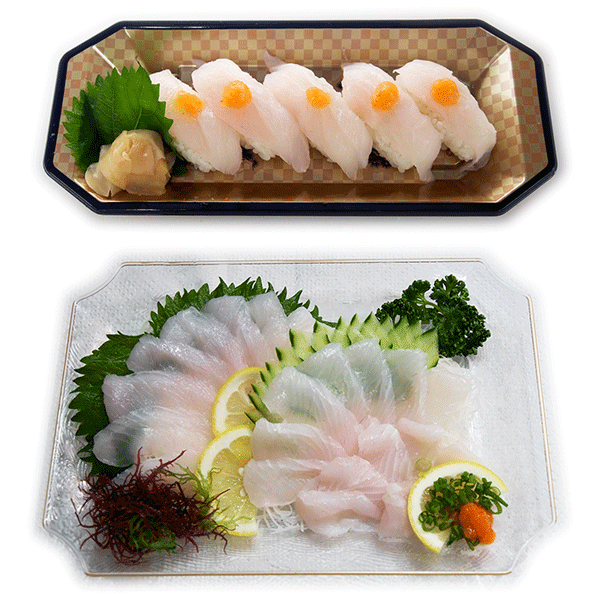
Liverless unicorn leatherjacket sashimi & sushi
Reconstructing the cut-out articles of FISH FOOD TIMES
This is the second issue of this month's issue, following the January 2006 issue of 15 years ago. Like last month's issue of largehead hairtail, it will be a fish species for re-pitching, but I thought that I was glad to try it again in last month's issue, including reflection on the largehead hairtail. And that has led to the re-appearance of this month's issue of unicorn leatherjacket.
The unicorn leatherjacket dealt with in the January 2006 issue was written on the premise of "tomoae sashimi" with a liver that grows in winter. When I think about it from now on, I only described things that made me wonder, "Is this really all right?" For this reason, the author decided to "recover the stigma of the cut-out articles at that time," as in the case of last month's largehead hairtail.
Speaking of leatherfish, summer is the best ...
There are three main types of leatherfish eaten in Japan: unicorn leatherjacket, black scraper, and thread-sail filefish.
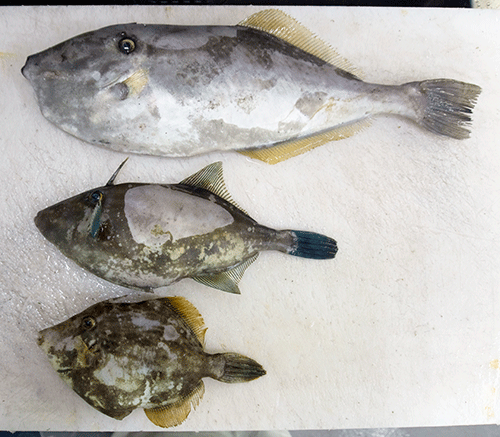
The upper part of the upper image is the unicorn leatherjacket, the middle part of the black scraper, and the lower part of the thread sail file fish. All belong to the family Filefish of the order Tetraodontiformes. They belong to the genus Aluterus, the genus Thamnaconus, and the genus Stephanolepis, respectively.Interestingly, the above image is an image taken by the author of all three species in the same fixed shore net, which were carried in the same fish box.(By the way, as an aside, on a ship that pulls up a fixed shore net, these types of leather fish may be thrown back to the sea one after another even if they are caught. Because various fish are bycatch from the fixed shore net and rampage on the way to the boat, the types of leatherfish have long and large sharp thorns on the head, and this sharp thorn seems to hurt other expensive fish. .. Black scraper, whose selling price cannot be expected, is hated by fishermen and is destined to be thrown away from the boat in order not to damage other expensive fish.It seems that the landing contents were very bad on that day, and it was not returned to the sea and became a product. This is not limited to the types of leather fish, but on the boat that pulls up the fixed shore net where various fish are bycatch, low market price fish such as dolphin fish are destined to be the same, and on the boat various selections depending on the fishing Is being done.)
These three species are like the cousins of Family: Monacanthidae, so although there are many differences in the details, there are also many similarities between the cousins. Its major feature is that it can be peeled off by pulling a thick, sturdy skin by hand. Below, you can see that the colors are slightly different, with those skins peeled off.
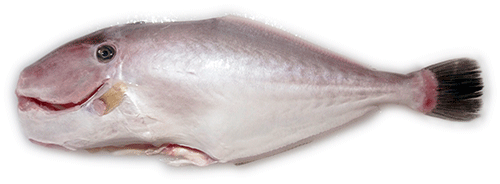
Unicorn leatherjacket
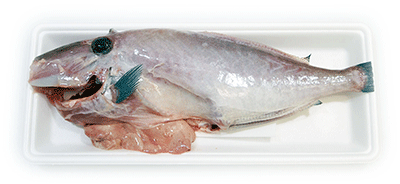
Black scraper
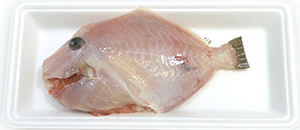
Threadsail filefish
Of the three species, the one with the highest price is the threadsail filefish, which has the lowest catch, and the cheapest is the Black scraper, which can be caught in large quantities at one time. And the unicorn leather jacket has the feature that the vertical width of the market is particularly large, because the freshness alone can be higher than the threadsail filefish, and sometimes it is cheaper than the Black scraper.
The reason why threadsail filefish is the most expensive is that its constitution is most suitable for raw food such as sashimi. Black scraper is basically easy to obtain in terms of quantity, and because of its price, it is often made into fillets and processed dried fish, and of course, if it is fresh, it may be made into sashimi. And the unicorn leatherjacket, which is the main character of this month's issue, is suitable for sashimi and sushi, and has the ease of use that can be widely applied to fillets.
All three types can be made into sashimi or sushi, but it can be said that summer is the time to make sashimi. I think readers may have heard the phrase "summer filefish is winter puffer fish". I don't think anyone thinks that the winter tiger puffer fish Tessa and the summer black scraper usutsukuri sashimi are the same, but rather than the summer tiger puffer fish that is out of season, We eat filefish sashimi during the summer season. It means that it is more delicious and reasonable.
The image below shows the size of the liver and fish egg of the Black scraper that was handled in May of a certain year. As you can see, the liver and fish egg are still growing so much in early summer. For this reason, it can be inferred that the state of nutrient accumulation in the body may be higher in summer than in winter when the liver grows even larger.
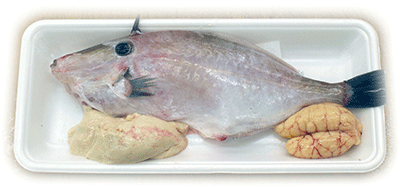
In other words, if you want to eat filefish sashimi, "summer is the best ...".
What role for what? Very hard, round bone
As for filefish sashimi, as mentioned above, the January 2006 issue of 15 years ago described unicorn leatherjacket, and the May 2013 issue of 10 years ago No.113 described Black scraper. So far, threadsail filefish has not been taken up as a theme yet, and it may be treated as an article in it. However, if anything, the catch is small and the price is the highest, so aquaculture is attracting more attention than nature, and there is a possibility that aquaculture such as red sea bream and amberjack will become mainstream, so the author wrote in the article. If so, it may be treated from that perspective.
Black scraper is mentioned in detail in No.113, so please refer to it, but since there are many things in common with unicorn leatherjacket, this month's issue will also double-explain the same thing as that article. Please forgive me because there are times when it is unavoidable to explain that point.
First, let's explain the work process of peeling the unicorn leather jacket with an image.
| Work process of peeling unicorn leather jacket | |
|---|---|
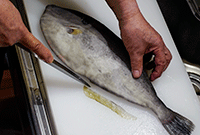 |
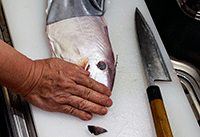 |
| 1,Separate anal fin. | 7,Turn the fish face down and pull the skin to the caudal fin side to remove all the skin. |
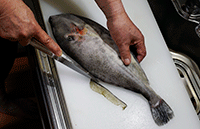 |
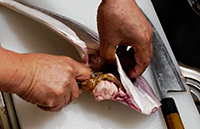 |
| 2,Separate the dorsal fin. | 8,Grip the internal organs with your fingers through the notch in the abdomen, being careful not to damage the liver. |
 |
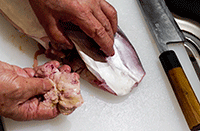 |
| 3,Make a cut between the fish body and the long degenerated bone of the pelvic fin. | 9,After removing the internal organs, carefully remove the liver so as not to crush it. |
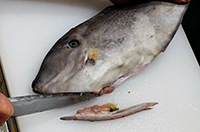 |
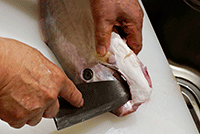 |
| 4,Separate the long bone from the fish body. | 10,With the head facing down, make a notch between the head and chin and cut off the base of the gills. |
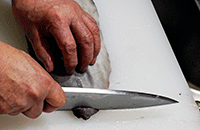 |
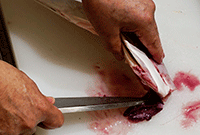 |
| 5,Cut off the tip of the mouth to make it easier to peel. | 11,Place the part of the deba knife near the tip of the knife against the gills, push down on the gills, and pull it forward. |
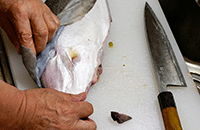 |
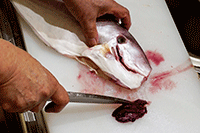 |
| 6,Starting from the separated mouth, peel the skin from the abdomen toward the dorsal fin. | 12,The state where the gills have been removed with a deba knife. |
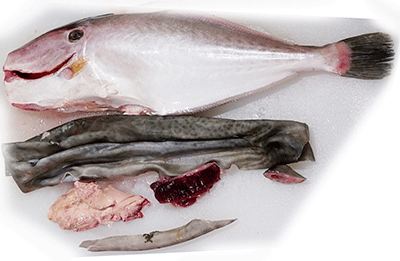 |
|
| Peeled unicorn leatherjacket | |
The above is the work process up to the peeling of the unicorn leatherjacket recommended by the author, but on the other hand, there is another method that is often used for black scraper, which is smaller than the unicorn leatherjacket, so I will introduce it below for comparison. Since the explanation of the process is similar to the above image, it will be simplified in a short sentence.
| How to peel the skin after separating the head | ||
|---|---|---|
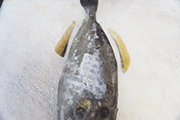 |
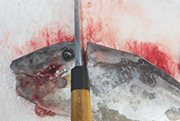 |
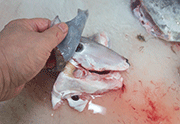 |
| 1,Separate anal fin and dorsal fin. | 5,Cut off the backbone with the blade root part of the Deba knife. | 9,Peel the skin on the head. |
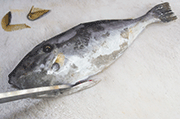 |
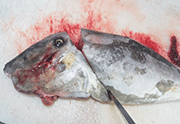 |
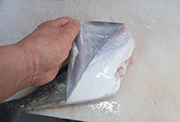 |
| 2,Cut off the long bones of the degenerated pelvic fin. | 6、Make diagonal cuts from the cut to both the upper and lower body. | 10,Peel off the skin of the fish body by pulling it from the cut end. |
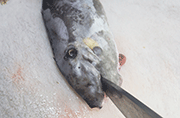 |
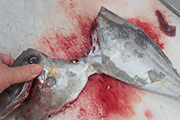 |
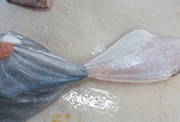 |
| 3,Make a notch to remove the gills. | 7,Separate the head from the fish body. | 11,Peel it off toward the caudal fin so that the entire skin is one piece. |
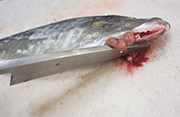 |
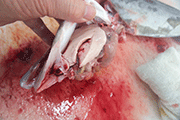 |
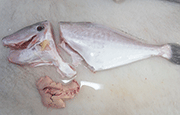 |
| 4,Place the cutting edge of the Deba knife against the gills and press it down to separate it. | 8,Carefully remove the liver located towards the head and remove the internal organs. | Peeled unicorn leatherjacket |
Now that the peeling work is complete, let's move on to the bone-in fillet.
| ウスバハギの切身作業工程 | |
|---|---|
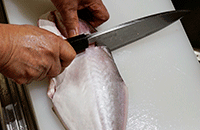 |
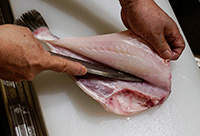 |
| 1,Drive the blade root part of the Deba knife into the base of the neck and separate the spine into the head and fish body. | 7,Go beyond the backbone to the dorsal fin with the one side disassembling work method. |
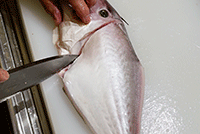 |
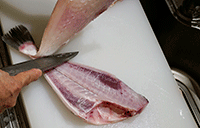 |
| 2,Cut diagonally from the notch of the Deba knife to the abdomen on both the upper and lower body sides. | 8,After cutting open the end of the dorsal fin, cut it toward the caudal fin and separate the lower body. |
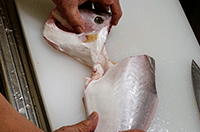 |
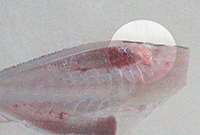 |
| 3,Separate the head from the fish body. | 9、One thing to keep in mind before making a fillet is the "very hard round bone" that is circled to emphasize the image. |
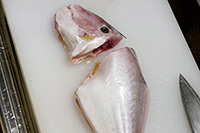 |
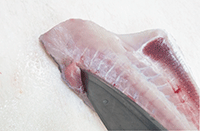 |
| 4,A state where the head and fish body are separated. | 10,This round bone is hard enough to bounce off the Deba knife, so use the tip of the Deba knife to dig it up and remove it. |
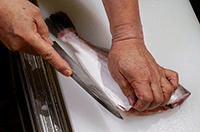 |
 |
| 5,Make a notch at the end of the anal fin on the lower body side. | 11,A state in which hard and round bones have been removed. |
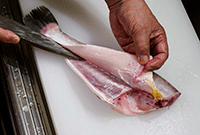 |
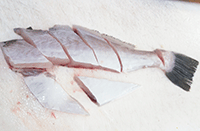 |
| 6,Cut from the end of the anal fin to the dorsal side. | 12,Cut the upper body with central bone to a size suitable for cooking. |
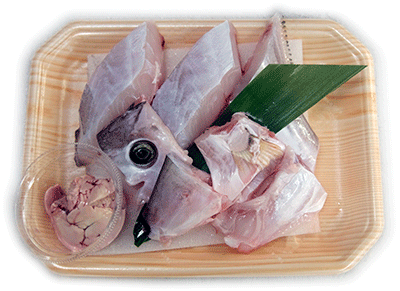 |
|
| Unicorn leatherjacket fillet | |
I'm very curious about what the "hard and round bones" that are unique to Unicorn leatherjacket exist for and what role they play, but I haven't found any material to explain this. If anyone knows, please let me know.
How to handle mikawa is important
Next is sashimi and sushi. Since the unicorn leatherjacket corresponds to the bloodline of the puffer family called the puffer order, there is a "mikawa" that is the skin under the skin like the tiger puffer. This work is a very important process not only for unicorn leatherjacket but also for cooking filefish relatives into sashimi and sushi, and if it fails, the repair work is troublesome and the finish of the product after that is greatly affected.
| Work process to separate unicorn leatherjacket mikawa and fish meat | |
|---|---|
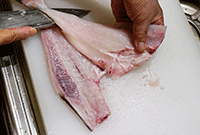 |
 |
| 1,Three pieces disassembling by the one side disassembling method. | 4,Upper body part seen from the mikawa side |
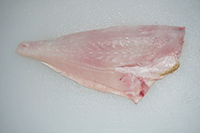 |
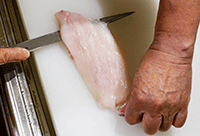 |
| 2,Three pieces disassembled upper body | 5,When removing mikawa, I try to avoid failure by moving the yanagiba knife slowly and carefully using the uchibiki method. |
 |
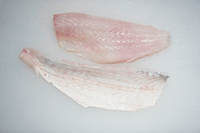 |
| 3、Remove belly bone like scraping. | 6,The state where mikawa is separated. |
In this way, we were able to separate the sashimi and sushi meat parts and the mikawa that does not, so we will change each into a form that makes the most of it.
| Unicorn leatherjacket sashimi and sushi commercialization process | |
|---|---|
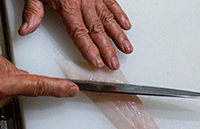 |
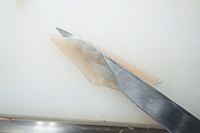 |
| 1,Do usutsukuri sashimi in the right posture. | 1,Cut into sushidane. |
 |
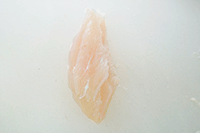 |
| 2,Do sogitsukuri sashimi in the left posture. | 2,I piled up some unicorn leatherjacket sushidane. |
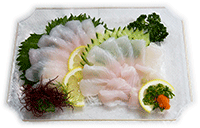 |
 |
| Unicorn leatherjacket usutsukuri sashimi | Unicorn leatherjacket nigiri sushi |
 |
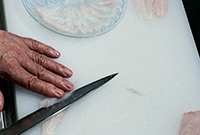 |
| 1,Boil mikawa lightly. | 1,Serve unicorn leatherjacket usutsukuri sashimi on a round thin plate. |
 |
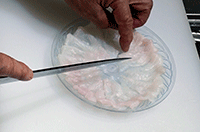 |
| 2,Carve the boiled mikawa using the sengiri method. | 2,Serve the unicorn leatherjacket usutsukuri sashimi counterclockwise while turning the round thin plate to the right. |
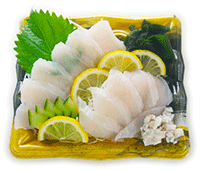 |
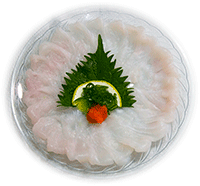 |
| Unicorn leatherjacket with boil mikawa of usutsukuri sashimi | Round thin plate of unicorn leatherjacket usutsukuri sashimi |
Delicious without liver
The filefish family tends to pay attention to the liver, but after all, the liver is positioned as an accessory and not a central entity. It is also doubtful how many people in ordinary households have the opportunity to make "liver soy sauce" with uragoshi liver and soak sashimi in it and eat it with "liver tomoae". In addition, the size of the liver varies depending on the size of the fish, the season, etc., and if the liver is large by cutting the belly, there is a hit or miss of good luck, and there is instability that it is not always possible to obtain a large liver. .. Furthermore, when it comes to eating the liver, which is one of the internal organs, freshness is also important, and it is natural that you cannot eat the liver with the freshness that gives off an odor. It is also a dangerous part.
When selling a unicorn leatherjacket, the liver should be regarded as an "addition". Rather than throwing away the "mikawa" that always comes out when making sashimi or sushi as an unnecessary part left after cooking, it is more important to incorporate it firmly as part of the product. I think there isn't. When commercializing unicorn leatherjacket, the liver is important in terms of increasing added value, but even if it is not there, it can be used as a product, so I want you to sell "Summer unicorn leatherjacket that is delicious even without liver" firmly.
By the way, I would like to finish this month's issue. Has the purpose of this time, "recovering the stigma of the cut-out article in the January 2006 issue 15 years ago," been achieved? This will be judged by readers, but since the article about black scraper in the May 2013 issue No. 113 10 years ago described the characteristics of filefish's relatives, this month's issue will be about that. I dare to avoid touching on my knowledge. For this reason, I think that the lack of knowledge should be read together with the article. We hope that the unicorn leatherjacket will sell more and more and the fish sales will improve in this summer when the epidemic of the new coronavirus is about to end.
| Please access the following URL if you want to secure using SSL. All pages in the site will be secure pages. |
https://secure02.blue.shared-server.net/www.fish-food.co.jp/message english 7.2021.html |
An opinion and the communication are to iinfo@fish food times
Date of updating 1 Jul. 2021
